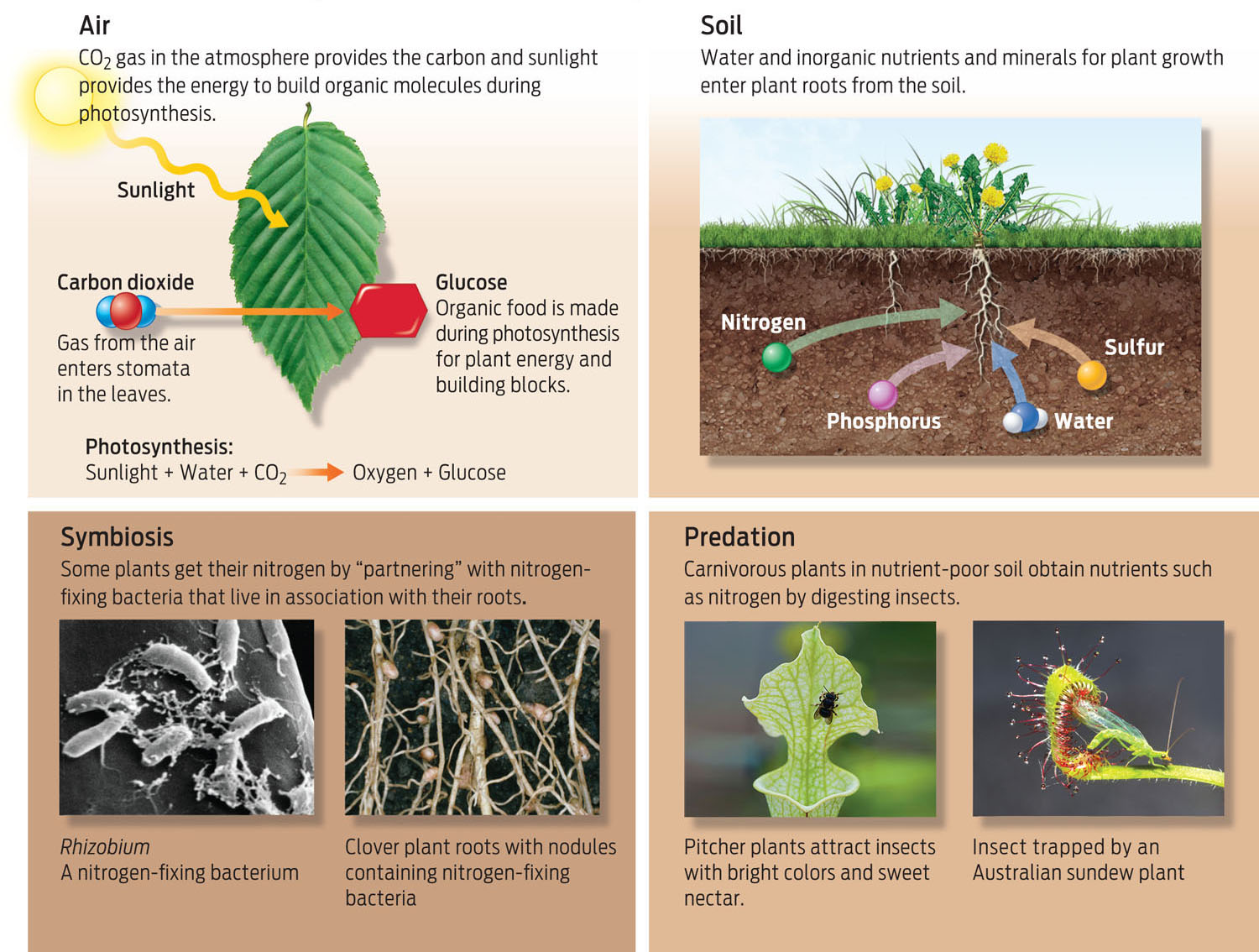Plant Nutrition
 What do plants eat?
What do plants eat?
ANSWER: This is a trick question, because plants don’t “eat” in the same sense that animals do. Plants are autotrophs, making carbohydrates from inorganic CO2 by photosynthesis. As discussed in Chapter 5, photosynthesis can be represented by the following equation:
Sunlight + Water + Carbon dioxide Oxygen + Glucose
NITROGEN FIXATION The process of converting atmospheric nitrogen into a form that plants can use to grow.
Give a plant some sunshine, carbon dioxide, and water—plus a few soil nutrients—and you will have a happy plant, capable of feeding and nourishing itself. From the air, plant leaves absorb carbon dioxide and sunlight, which they convert into sugar through photosynthesis. Sugar is a source of energy and building blocks for the plant. From the soil, plant roots absorb both water for photosynthesis and other nutrients—nitrogen, phosphorus, and sulfur—that are required to make plant proteins and other molecules.
Although nitrogen gas is plentiful in air pockets in the soil, it exists there in a form that is essentially unusable by plants. Luckily, bacteria within the soil are able to convert nitrogen into a form that can be used by plants, a process called nitrogen fixation. Some of these bacteria, like members of the genus Rhizobium, can even live symbiotically with a plant’s roots, forming lumpy structures called root nodules on the roots of legumes. By making plant growth possible, nitrogen-fixing bacteria play a critical role in supporting nearly all life on the planet (for more on the nitrogen cycle, see Chapter 23).
Fertile soil naturally contains nitrogen-fixing bacteria and therefore provides adequate supplies of usable nitrogen that plants can absorb and use to grow. And soil can be supplemented with fertilizer, giving plants a boost of artificial nitrogen and other nutrients. But in certain natural environments, such as bogs or rock outcroppings, it’s hard for plants to obtain the nitrogen they need. The acidity of a bog, for example, prevents organic matter from breaking down, so nutrients are recycled more slowly. In these environments, plants have evolved novel ways to obtain scarce nitrogen—some of which would put animal carnivores to shame.
Trumpet pitchers (Sarracenia), for example, lure insects with brightly colored flowers and nectar “bribes.” But the rim of the plant’s trumpet-shaped flower is slippery. Unsuspecting trespassers climb onto the rim, lose their grip, and tumble into a deep cavity filled with digestive juices. Prevented from escape by downward-pointing spikes, the tiny prisoners drown and are slowly dissolved. The resulting insect soup—a rich source of nitrogen—is absorbed by the plant.
The Venus flytrap (Dionaea muscipula) takes an even more dramatic approach. The plant’s “flower” is actually a spring-loaded trap that snaps shut around unsuspecting prey. Tiny hairs inside the flower act as sensors; when the sensors are tripped by a moving insect, the trap slams shut and the feasting begins.
Even when plants obtain nitrogen in this “carnivorous” way, they must still perform photosynthesis to make sugar. The plant body is composed of complex carbohydrates, such as cellulose, which the plant makes by stringing sugar molecules together. And the starting material for photosynthesis is carbon dioxide gas. Thus the air, rather than the soil, is where a plant obtains the material to put on weight (INFOGRAPHIC 32.3).
Plants obtain carbon from atmospheric CO2 during photosynthesis. They obtain minerals and nutrients such as nitrogen from the soil, or sometimes through other means.
